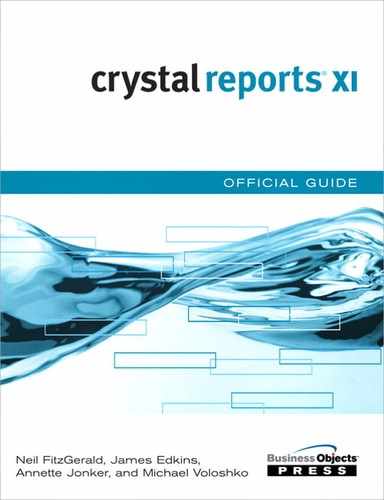Chapter 24 Using InfoView
Using BusinessObjects InfoView 571
Chapter 23, “Introduction to BusinessObjects Enterprise,” provided an introduction to the BusinessObjects Enterprise infrastructure. Building on that, this chapter describes InfoView, a user web-based application for interacting with content published to BusinessObjects Enterprise.
From an architectural standpoint, InfoView is based on a published application programming interface (API) as described in Part VII of this book, “Customized Report Distribution—Using BusinessObjects Enterprise and Crystal Reports Server.” This effectively means that the InfoView application is customizable and in fact, the source code for the applications ships with them.
Prior versions of Crystal Enterprise included an application called Web Desktop or ePortfolio. Prior versions of BusinessObjects included a web-based application called InfoView. This is the successor to those versions and includes functionality from both Crystal Enterprise 10 Web Desktop and BusinessObjects 6 InfoView.
Installing InfoView
InfoView is developed to run in a multitiered architecture on both the Java and .NET frameworks. The multitiered architecture results in the processing load being spread over the Web Server, Application Server, Reporting Server, and Database Server. These two editions are, for the most part, identical in functionality, and both can be run simultaneously on a server that supports both the .NET and J2EE frameworks. This becomes useful when dealing with heterogeneous environments when an organization might have both Java and .NET environments.
Installing the Java Edition
Desktop.war is the application that needs to be deployed on the Java Application Server. For a listing of supported application servers, see Platforms.txt on the BusinessObjects XI CD. The supported Java Virtual Machine (JVM) is the same JVM the appropriate Application Server supports. See the associated Application Servers documentation on how to deploy a WAR file. Likewise, the supported Web Server is whatever the associated Application Server supports.
This Web Archive or WAR file can typically be found after installation under /Business Objects Enterprise 11/java/applications/desktop.war. InfoView requires components of the Java API to run; however, this WAR file includes all the Java API JAR files required, hence this is self-contained and has all you need to deploy and run InfoView on a Java Application Server.
Installing the .NET Edition
The .NET InfoView version is an ASP.NET application that runs on Microsoft’s Internet Information Services (IIS) versions 5 and 6. If this is selected at installation time, the install will search for IIS on the server and attempt to install InfoView. This is an ASPX application, so IIS needs to be set up accordingly to allow ASPX pages to be run. Consult your product (IIS) documentation for the appropriate configuration.
Like its Java version, the .NET version of InfoView is based on the BusinessObjects .NET Software Development Kit (SDK) and hence this is also required on the server, or at least access to the assemblies needs to be granted. It requires the .NET Framework on the IIS server and if one is not found, it will install version 1.1. If a different version or configuration is required, it is generally recommended that the framework be installed ahead of time.
A default install will create a virtual mapping on IIS called BusinessObjects and this will map to a local path of c:Program FilesBusiness ObjectsBusinessObjects Enterprise 11Web Content. Under this virtual directory of BusinessObjects, you will find a subfolder of Enterprise11 and below that you will find an InfoView folder that stores all the required files for the InfoView application. Hence, the default URL for accessing the .NET version of InfoView is http://<Server>/businessobjects/enterprise11/InfoView/.
By default, this URL usually runs logon.aspx, which is different from previous versions of Crystal Enterprise.
Using BusinessObjects InfoView
InfoView is accessed via a URL in a supported web browser. A typical URL would look something like this:
http://<WebServer>:<port number>/businessobjects/enterprise11/InfoView/
The user specifies the name of the web server, his username, and password. He also needs to specify what form of authentication he wants to use, such as Enterprise, Active Directory, LDAP, or one of the ERP integration kits (for example, SAP). See Chapter 27, “Administering and Configuring BusinessObjects Enterprise,” regarding authentication configuration, and see Chapter 15, “Additional Data Sources in Crystal Reports,” regarding ERP authentication.
Upon successful logon, a session is created on the Enterprise server and the user is taken by default to a welcome page. The starting page for InfoView can be changed by the user and this is explained in the Customizing InfoView section of this chapter.
The starting page is broken down into four sections, as shown in Figure 24.1.
Figure 24.1 The InfoView XI welcome page.

Each of the sections permits the hiding or showing of each section as deemed appropriate by the user. For example, when viewing a report, the user might want to hide the folder section to maximize the report viewing area. This is accomplished by clicking on the Expand or Collapse button.
The Toolbar Section
This section is found along the top of the browser viewing window and allows for the following functions:
- Takes the user back to her initial view. The user can customize her initial view.

- Collapses the Navigation section, described in the next section. This is used to increase the viewable area when looking at documents.

- Expands the Encyclopedia section for a particular object.

- Allows the user to create a new document. The content of the new document list is determined by what the system is licensed for. To upload documents from the local disk or a networked drive, select the Document from Local Computer option. BusinessObjects XI can then become a document repository for all the supported document types displayed.

- Refreshes the screen to reflect any changes, such as new documents that have been published. Users often wonder why they are not seeing all of their documents and sometimes all they need to do is refresh their screens.

- Permits the forwarding of documents to destinations such as email, disk, inboxes, and FTP locations. Each specific destination needs to be enabled by a system administrator before users can successfully send documents to that location. See Chapter 27 regarding the setting up of these destinations. The default values referred to here are the defaults specified by the administrator when setting up these destinations. The available options change depending on the destination selected; for example, when forwarding to a person’s inbox, a user can choose to forward either the document or a shortcut to the document. This option is not available when forwarding to an FTP site because FTP is usually used to forward the complete document.

- My InfoView is a web page the user can customize to display documents or parts of documents that might be of interest to the user. For example, a shipping manager might want to periodically check the status of shipments. To do this, he uses multiple reports. Instead of having these reports linked together, he might want to display them all on one page to get a complete view of his shipping operations. See the “Customizing InfoView” section for more detail on customizing My InfoView. It should also be noted that My InfoView is also referenced as a Single Dashboard in Business Objects parlance.

- You can search using different object properties and locations.

At the start of an implementation when the Enterprise system hosts relatively few objects, users and administrators often leave the object properties blank. As the number of objects grows, these property fields allow for effective searching, so establishing guidelines for populating these fields at an early stage might serve you well at a later stage.
- A user can set the preferences to tailor InfoView for his individual requirements. A detailed description of these preferences is defined later on in this chapter under the “Customizing InfoView” section. Whether this icon is displayed for the user is defined in the Central Management Console (CMC) under the Applications section. See Chapter 27 for more information.

The Navigation Section
The Navigation section of InfoView is found along the left side of the browser viewing area and allows the user to move between her various folders or categories to locate and manage objects. Folders provide physical locations for reports. A company division might establish a folder structure. A category would define the type of report, such as finance or Sarbanes Oxley reports. Somebody in the finance department might be interested in all finance reports across all divisions and use the Category view, whereas a divisional manager might want to see only the reports associated with her division, so the folder view would be more appropriate.
Every user created by Enterprise XI is assigned a Favorites folder, a Personal category, and an inbox. By default, only that user and the group administrators have rights to these three objects.
The user will only see the folders or categories to which she has appropriate security rights. For more details on creating folders and categories and their applicable security settings, see Chapter 27.
The Workspace Section
This section is the largest section and is found to the right of the folders and below the Toolbar sections. It displays the objects residing in the folders or categories. The available actions are shown for each object after the folder is selected. These actions are a combination of the user’s rights and the permitted actions for the object type. See Table 24.1 for a listing of what actions are permitted for each object type.
Table 24.1. Permitted Actions by Object Type

You can then click on the appropriate action to execute that function.
View Function
The object is rendered in its chosen viewer. For example, Web Intelligence or WebI reports are rendered in the WebI viewers and a PDF document is rendered in its viewer.
Related to the View function is the Saved View function and View Latest Instance function. The Saved View function applies to OLAP Intelligence reports only. A specific view of the data can be saved, allowing the user to return to those specifically aligned dimensions and dimension members. The View Latest Instance action allows the user to view the most recently scheduled instance. This is useful if a user wants to view the most recent version of the scheduled report. This action is often provided to the majority of end users, with the ability to View (On-Demand against the database) provided to only an elite segment of users.
Crystal Reports, Web, and OLAP Intelligence can have multiple viewers. The viewer is determined by the user preferences described in the “Customizing InfoView” section.
Before continuing, it is worth investigating these report viewers in a little more detail.
The Crystal Reports viewers take the data from the BusinessObjects XI platform and format the data into a report so it can be viewed.
Table 24.2 provides a listing of the base functionality all the Crystal Report Viewers provide.
Table 24.2. Crystal Report Viewer Functions

The look and feel of the Crystal Reports viewers is consistent with the Crystal Reports Designer, and the output displayed in the Crystal Reports HTML preview should be consistent with InfoView. The drill down function, as described in Chapter 2, “Selecting and Grouping Data,” is honored by the viewers, and users can drill down on charts, group sections, and the group tree.
The Crystal Reports viewers delivered as part of InfoView are either client-side or server-side viewers. The server-based viewers can be cosmetically changed or functionally modified via a Java, COM, or .NET object model. This is further described in Chapter 33, “BusinessObjects Enterprise—Customizing the Crystal Reports Viewers.”
Server-Side Viewers
The server-side viewers run within the application server framework. For example, the Java DHTML viewer consists of Java classes that run within the Java Application Server.
Upon receiving a report request, the Enterprise XI framework sends the data in Encapsulated Page Format (EPF) to the Application Server. A viewer object is instantiated and the Application Server processes the EPF pages. DHTML consisting of both the data and the viewer controls is then sent through to the web server.
DHTML Viewer
The DHTML Viewer provides a rich functional interface for viewing and navigating Crystal Reports in a zero client interface. This zero client viewer is implemented via viewreport.aspX, or in the Java environment via viewreport.jsp.
Advanced DHTML Viewer
The advanced DHTML includes all the functionality of the DHTML viewer but also includes an Advanced Search Wizard that has the capabilities to search for data in the data source by setting conditions and to return the data in table form.
Use the Advanced Search Wizard icon to toggle the report to display the Advanced DHTML Viewer options, as described in Table 24.3.
Table 24.3. Advanced DHTML Viewer Options

Web Intelligence HTML Query
With the correct setting, a user can create and perform on-report analysis and view reports using pure DHTML, as shown in Figure 24.2. At the time of publication, this was only available in the Java version of InfoView. For more information on Web Intelligence, see Chapter 20, “Introduction to Web Intelligence.”
Figure 24.2 The HTML Query panel shown in InfoView.

Web Intelligence HTML Report Panel
The HTML report panel provides basic reporting creation capabilities. At the time of publication this was only available in the Java version of InfoView.
Mobile Viewer
The mobile viewer allows the user to simulate viewing reports over a WAP-enabled mobile phone or web-enabled PDA. The design paradigm is simple, with only a certain number of characters fitting across the page into the device display area. Additionally, these devices typically have limited bandwidth, so transferring large reports with thousands of rows is not an acceptable end-user experience. The mobile viewer requires that the involved report contain a part that allows the user to see the critical piece of the report.
Client-Side Viewers
The client-side viewers require some components to be downloaded and executed on the client (browser). The client-side viewers do offer some enhanced printing and functionality enhancements. Additionally, as a result of the initial download to the client, some of the report processing is performed on the client.
ActiveX Viewer
This viewer is available using Microsoft Internet Explorer supporting ActiveX controls. Over and above the standard viewer functionality previously described, this viewer allows users to freeze the panes; in other words, the users can scroll across or down the report and “frozen” sections will remain part of the viewable area, as shown in Figure 24.3. This is achieved by right-clicking on a field where you want the panes to the left and above to be frozen. This allows the user to scroll while the heading and other sections remain frozen.
Figure 24.3 The ActiveX viewer allows sections of the viewer to be frozen, illustrated by the lines on the viewer.
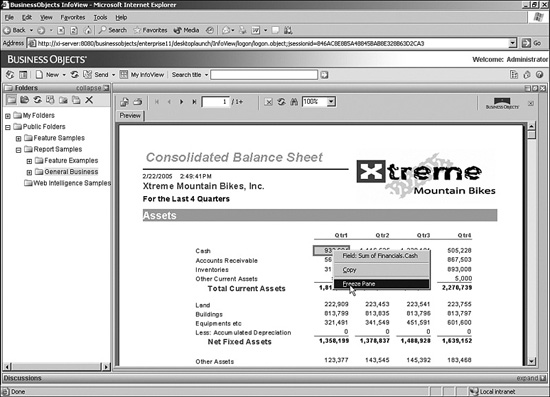
The user can also copy a cell value from a report by right-clicking the cell and selecting Copy from the drop-down menu.
Java Viewer
The Java Viewer is a client-side viewer that is downloaded. It requires a suitable Java Virtual Machine (JVM) be running on the client. If one is not available, the user is prompted to install one.
Web Intelligence Java Report Panel
The Web Intelligence Java report panel requires a Java applet to be downloaded but then adds the flexibility of drag-and-drop formula creation. This option is available for both the .NET (see Figure 24.4) and Java versions of InfoView.
Figure 24.4 InfoView displaying the Java report panel.

Schedule Function
With the required permissions, the user has the ability to schedule an object, specifying the following input to ensure the report runs appropriately. Each object allows for different options depending on the object type. For example, when scheduling a Crystal Report, you can specify a database logon. This option is not available when scheduling a program object. Table 24.4 describes all the available options, although some options might not be available, depending on the object type.


Figure 24.5 Scheduling based upon a custom calendar.

The defaults described here are established by the administrator when enabling the Destinations in the CMC under the Destination Job Server.
If a business requirement is such that the users are going to do a lot of exporting, determine the format and how the user wants to view the exported format before designing the report because the export will have an effect on the design of the report.
Check http://support.businessobjects.com for technical papers on preferred formatting and export limitations when the report is intended to be exported to another format.
The ability to e-mail users based on the triggering of an alert must be set up in the CMC. Alerts will still be triggered but a message will not be sent unless you enable the alert notification.
History Function
The history shows the user a listing of all attempts to schedule the report and the status of those attempts, whether they succeeded or failed. The user can click on the status to view reasons for failing or succeeding. If the report succeeded, the user can click on the date-time stamp of the instance to view the report instance. If the report failed, the user can reschedule the report by selecting the report instance and clicking the Reschedule button.
This ability to return to a previous instance makes comparing data from previous dates easy. For example, if the user wants to know what last month’s inventory value was, he could just click last month’s instance, without having to rerun the report with different date parameters.
The function also provides a good audit trail of what report was run, who ran the report, and the data generated.
Instances can be removed from the system using the CMC. The company should set a policy; for example, keeping the last 30 instances or moving a year’s worth of data for that particular report.
Modify Function
If Enterprise XI has been installed with the Report Explorer application or Web Intelligence reports, the user will have the ability to modify Crystal Reports or Web Intelligence reports. In the case of Crystal Reports, clicking the Modify button launches the Report Explorer, and with Web Intelligence objects, the report will be opened with edit capabilities.
Alert Function
Should the report have an alert that has been triggered, the report will appear on the alerts page. The user can go directly to the alerts page and see if there are any reports that have triggered an alert.
Object Properties
The properties action allows the user to set the properties of the objects. The Title, Description, and Keywords sections are useful for searching. Some of the date properties are exposed and, finally, the user can assign the report to a specified category.
The Workspace section also includes the ability to organize objects into different folders and is described in Table 24.5. To add or change the appropriate category for an object, click on the properties action. Check or uncheck the category to add or remove the object.
Table 24.5. Functions Available in the Workspace Section

Under the Administrators Tools Console (not the Central Management Console), there is an application called Shortcut Manager. This application removes any orphaned shortcuts from a specified folder and all of its subfolders.
The Encyclopedia Section
The Encyclopedia provides useful information about objects stored on your BusinessObjects Enterprise system. Especially in large environments where there are a lot of users generating their own reports and sharing these reports, it is quite common for users to use the wrong report to answer their business questions. To compound this issue further, often the business uses particular columns in a report, such as a custom calculation or a business term, and the user misinterprets the term or doesn’t understand the underlying calculation.
To solve these problems, BusinessObjects introduced the Encyclopedia. This tool provides information about the report itself, providing users with what the report is and why and when they should it. This type of information is particularly important for end-user–built reports and for new users. Furthermore, should a definition change, the administrator can see all reports that are associated with the definition. He can also make a change to the definition and all associated reports will see the change.
This functionality was available in XI R1 but as a separate install. It is now included with the default install for XI R2.
Administration of the Encyclopedia takes place through the Central Mananagment Console or CMC (see Chapter 27, “Administering and Configuring BusinessObjects Enterprise”). To administer the security from the CMC, click BusinessObjects Enterprise Applications and then select the Discussions application.
From here you can assign users or groups that have access to modify the Encyclopedia content as shown in Figure 24.6. You can also do this through the CMC by clicking BusinessObjects Enterprise Applications and then selecting the Encyclopedia application.
Figure 24.6 Managing access to the encyclopedia.

User access is defined in the CMC, enabling the administrator to define who can edit Encyclopedia content or not.
The Encyclopedia section is broken down into four areas, which are described in Table 24.6.
Table 24.6. Components of the Encyclopedia

The Discussions Section
The Discussions Viewer found along the bottom of the browser’s viewing window (collapsed in Figure 24.1) allows the user to make notes or annotations associated with the object. For example, the sales manager might want to post a note specifying that sales were below what he had expected. Sales representatives could then post their responses to the relevant sections of the report. Users can add notes as an update to an existing note, creating what is called a discussion thread, or they can create a new note, starting a new thread. The available functionality is described in Table 24.7.
Table 24.7. Functions Available in the Discussions Section

Figure 24.7 The Dictionary section of InfoView, displaying all four sections.

In many organizations, this discussion thread usually takes place in the form of email. The Discussions section now incorporates this into the Business Intelligence platform, storing references to reports with the report object.
Customizing InfoView
There are three ways you can change the look and functionality of the InfoView application. Administrators can globally change the behavior of InfoView for all users. The users, if permitted, can set their preferences by selecting the Preferences icon. Finally, because this application is based on a published API, the application can be modified by changing the underlying code.
Crystal Server Pages (CSP) has been deprecated for both the UNIX and Windows platforms. Although CSP on the Windows platform might still work, it is recommended that any custom ePortfolio CSP pages be migrated to JSP pages for the UNIX platform or ASPX pages for the Windows platform.
Global InfoView Settings
During the implementation of the InfoView, an organization might want to globally change the InfoView application to tailor the application to suit its needs. This might include cosmetic changes such as adding its logo or security changes that remove certain functionality from the users.
The changes made to InfoView will change the application in its entirety and will affect all users. This differs from the user preferences discussed later in the User Preferences section because those preferences are saved on a user-by-user basis and not for the InfoView application as a whole.
To access the InfoView administration page, the administrator or a user with administrator rights can, via the CMC, click the BusinessObjects Enterprise Applications and then select InfoView. This should open the page seen in Figure 24.8.
Figure 24.8 The properties page of InfoView.
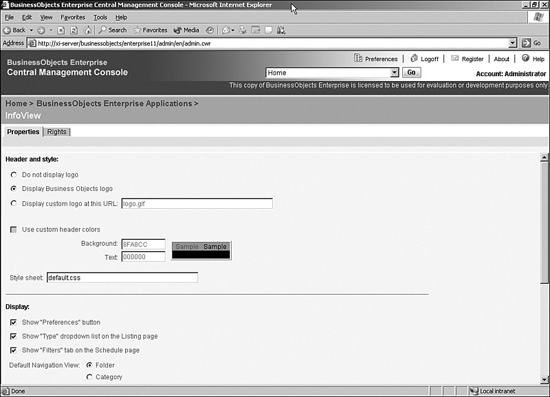
Header and Style
The properties page is broken down into multiple sections as described in Table 24.8.
Table 24.8. InfoView Cosmetic Change Options
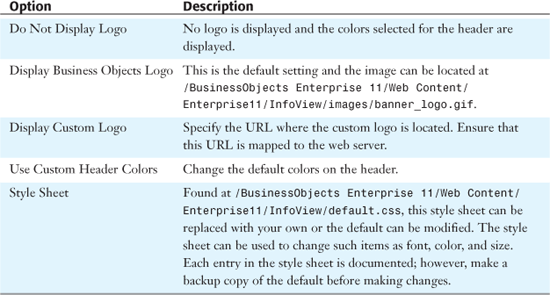
Display
This section hides or displays certain features, as described in Table 24.9.
Table 24.9. Global Display Features of InfoView

Objects Listing
If a user has view rights, he can click the object’s title to view the object. The administrator can select between either running the object against its data provider or against its latest successful scheduled instance.
Viewers
If checked, this option allows the users to use the Advanced DHTML Viewer. The Advanced DHTML Viewer enables report modification and this requires that the Report Application Server be running. See Chapter 27 for more information on the Report Application Server.
The Default Viewer sets the default viewer for InfoView when viewing Crystal Reports.
The User Preferences
A user can set or change her individual InfoView interface and interactions with user preferences.
General Preferences
The General Preferences tab of the Preferences screen provides access to a number of customizable user display settings for InfoView XI. These are described in Table 24.10.
Table 24.10. General Preference Settings for InfoView
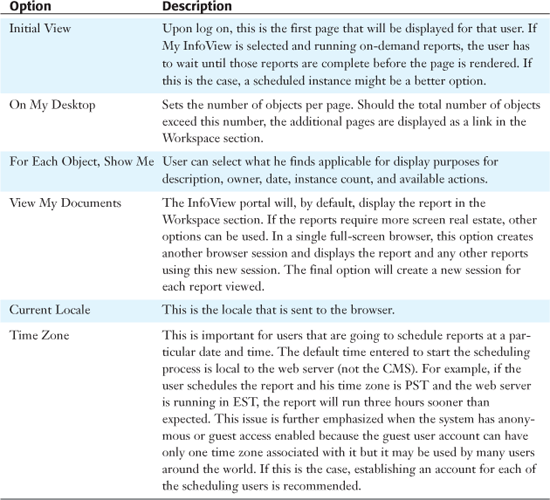
Web Intelligence Document Preferences
The preferences for Web Intelligence documents will differ by the platform on which Business Objects is installed. The differences are explained in Table 24.11.
Table 24.11. Web Intelligence Preferences

OLAP Intelligence Preferences
If Enterprise XI is licensed for Crystal Analysis, the user can select between running the ActiveX (sometimes called the rich client) or the DHTML versions of the viewer.
Crystal Reports Preferences
This page allows the user to set preferences specifically around the Crystal Reports viewers. Table 24.12 highlights the different options available.
Table 24.12. Crystal Reports Preferences

The final two tabs are the Password tab where the user can change his password and the About tab that describes the version.
Customizing My InfoView
My InfoView is a page that allows a user to add the most important report or report parts onto a single page. Each frame within the template can contain one reference. The reference can point to a supported object type, such as Crystal Reports, a Crystal Reports part, an instance or an instance filtered by username, a Web Intelligence report, an OLAP Intelligence report, any Microsoft Office document, a PDF, or a hyperlink. After the page is complete, it can be saved by clicking the Save link, which will save the page to the user’s Favorites folder. Multiple versions of My InfoView can be saved by using the Save As link. The My InfoView button launches the object called My InfoView from the user’s Favorites folder. If this page is deleted, clicking the My InfoView button brings up a blank page and the user can re-create the page.
To create this page, click the My InfoView icon and select a template from the list. This can alternately be accomplished by choosing the New drop-down box and selecting Single Dashboard. If the user is unsure of what the template looks like or which one will be best suited to her needs, she can select the template (see Figure 24.9) and preview it. If all the templates are unsuitable, the user can select the Split Screen button to split the screen horizontally, vertically, or a combination of the two.
Figure 24.9 Select a suitable template for your InfoView.

After the user is satisfied with the page splits, the user selects the Define Content link for each section of My InfoView to define the object that will populate that section. This brings up the form where the user selects the object she wants to display in that pane. The selections on the right are context sensitive to the object selected. For example, if the user selects a Crystal Report, she gets to select whether she wants a report part or the whole page, as shown in Figure 24.10. If the user selects a Web or OLAP Intelligence report, this option does not appear because report parts are not supported with this object type.
Figure 24.10 The Crystal Report Specific Options area has options for defining the content of a pane within My InfoView.
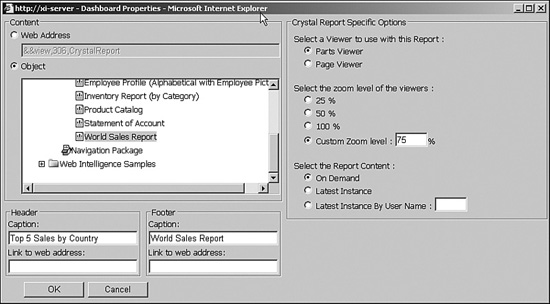
The Object list displays only what the user has the rights to see. Also, if the view time security has been defined by either a Business View or universe, the data displayed is limited to only what the user is allowed to see. See Chapter 18, “Using a Semantic Layer—Business Views and Universes,” for more information.
After the user is satisfied, she can return to My InfoView to see the result. If the object is too large for the pane, a scrollbar will be automatically added (see Figure 24.11). The user can repeat the process until all the panes on the page are populated.
Figure 24.11 A report part added to My InfoView.
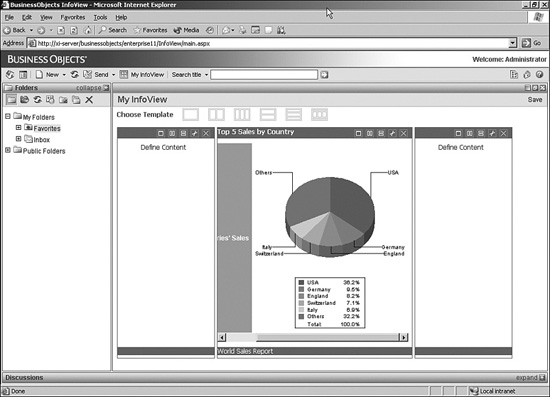
Programmatically Customizing InfoView
As mentioned earlier, InfoView is based off of a published API. The use of this API is described in Chapter 30, “Using the BusinessObjects Enterprise APIs.” Some configuration files require further explanation.
Web.xml in the Java version and web.config in the .NET version of InfoView contain certain settings where an administrator can functionally and cosmetically change the way InfoView works.
In the Java edition, the web.xml file (usually located under the WEB.INF directory) contains some of the settings that might be of use to an administrator (see Table 24.13). This XML file is well documented and an administrator should be able to determine what each tag describes.
Table 24.13. Some Useful InfoView Settings from Web.xml

Troubleshooting
Expected Changes Not Appearing in InfoView
After making changes to modify the look of InfoView, such as updating the logo, I don’t see the changes.
In a lot of cases, the browser will cache the page or logo. Delete the cache and restart the browser.
Crystal Reports Not Appearing in My InfoView
In My InfoView I select a Crystal Report as an object I want to display, but when I execute My InfoView, I get the error “Sorry, you do not have the right to execute this action. If you require this right, please see your system administrator.”
This error is caused by selecting the latest instance option (the default) for a Crystal Report when there is no instance created. This is solved by either creating an instance or requesting that the report run on demand.
Looping Logon Error
I am unable to schedule or view a report and InfoView continuously prompts me for a database logon.
The database logon is the user that is required to access the database. In other words, if the report accesses an Oracle database, the user entered here would be the user that Oracle authenticates against. However, should the Oracle database reside on a different physical server and network authentication is required to access the Oracle server, a user account that has access to this server needs to be established. This account should then be used to start the Job Server and Page Server.
